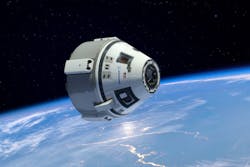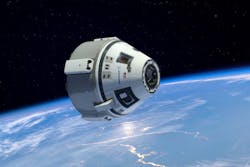COTS in space: A discussion of radiation-hardened components, protection, cost savings
Response to “Mission assurance, risk management, and cost, continuing the space COTS discussion” article in Intelligent Aerospace, 9 June 2017, by Daniel Gleeson, MSc., space business development manager, Curtiss-Wright
By Dan Friedlander
Retired following 44 years in components engineering
I welcome the responsiveness of Daniel Gleeson to open a professional discussion on the subject of use of commercial off-the-shelf (COTS) technologies in space.
Mr. Gleeson is correct stating "Mr. Friedlander provides his response without visibility into the details of the Smart Backplane design”, a fact stated explicitly in my previous feedback article. Unfortunately, no additional concept details have been yet disclosed in this discussion. My remarks were addressing mainly the concept of the innovative Smart Backplane approach.
As stated before by me, risk management is the name of the game. Of course, the equipment shall meet the specific mission criticality, orbit, duration, outage requirements. Due to obvious lack of visibility into what are the used criteria for defining "critical missions" and manned missions," I stated that the reported use of the subject innovative concept in a manned mission where "the equipment gathers data from critical vehicle sensors used by onboard computers to make decisions during the flight of the CST-100" is a surprising achievement.
I would like to reiterate the main points raised by me, following my understanding of Mr. Gleeson’s original article. Addressing these issue is the essence of this discussion.
The original wording of Mr. Gleeson’s article led to the following understanding (the article being the only available information for me):
a. It is understood that the approach is an evolution of a non-space standard version, namely using existing design. The original article statement "The plug-in COTS modules used in the system are manufactured with commercial components" implies that the explicitly mentioned "standard plug-in COTS modules" are identical to the non-space version. In other words, the mentioned "buy-and-fly approach" is applicable for these modules. Understandable, tests (radiation, upscreening) are expensive. It is not understood whether indeed tests are done (exclude design validation tests).
b. The main issue not yet addressed is the feasibility and the efficiency of SEE external protection at module level. The technique of switching off the power in order to protect components from SEL is known as a last resort method, not as a method to base an approach on. If the expensive radiation tests are avoided, how can one know the SEL current level to trigger the protection circuit and the timing needed to avoid damage and not compromise the relevant components reliability? How would one assess the component SEL sensitivity (SEL occurrence probability)? There is a limit of sensitivity that limits the use of this design method. What about other destructive SEE (SEGR, SEB)?
c. The 75 percent cost savings is still an extremely high percentage, also considering the cost of the radiation-hardened components in the smart module.
Author biography
The author has graduated ENGINEERING SCHOOL/TEL AVIV UNIVERSITY, physics 1965-1969. He has 44 years of experience in Component Engineering at MBT/ISRAELI AEROSPACE INDUSTRIES, 1969-2013, as Head of Components Engineering. He was responsible for all aspects of EEE Components (policy making, standardization at corporate level, approval, etc.) for military and space applications. Retired/Consultancy: 2013 - present. Further details of experience: see https://www.linkedin.com/in/dan-friedlander-63620092?trk=nav_responsive_tab_profile
RELATED READING
RELATED READING
Protecting COTS space electronics at the component and module levels, a discussion
Lowering the cost of spacecraft avionics with radiation-tolerant COTS electronics
COTS/EEE parts in space applications: evolution overview, revolution forward view
Search the Aerospace & Defense Buyer's Guide
The go-to resource for Intelligent Aerospace technology news & information:
Covering key topics
Across all market segments
Subscribe to the free Intelligent Inbox e-newsletter
Subscribe to receive all the latest aerospace technology news & information, delivered directly to your e-mail inbox twice a week (Tuesdays and Thursdays). Sign upfor your free subscription to the Intelligent Inbox e-newsletter at http://www.intelligent-aerospace.com/subscribe.html.
Connect on social media
Keep pace with aerospace innovation and opportunities via your favorite social media channels. Connect with Intelligent Aerospace on Twitter (@IntelligentAero), LinkedIn,Google+, and Instagram.



